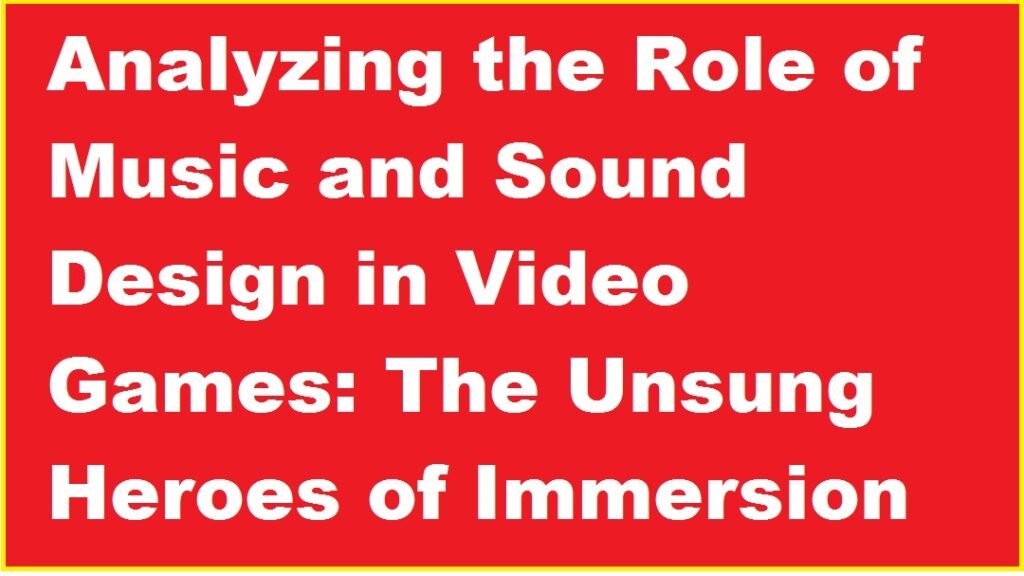Analyzing the Role of Music and Sound Design in Video Games: The Unsung Heroes of Immersion

While the dazzling visuals of video games often steal the show, captivating players with stunning landscapes and explosive action sequences, a hidden world of sound lies beneath the surface. This world plays a critical role in shaping the entire experience. Music and sound design are not mere background embellishments; they are the unsung heroes of immersion, weaving a tapestry of emotions, enhancing storytelling, and even influencing gameplay mechanics.
This article delves into the multifaceted world of music and sound design in video games, exploring their functions and highlighting their profound impact on the player’s journey.
Setting the Stage: Mood and Atmosphere
Imagine a heart-pounding chase scene through a gritty cyberpunk alleyway. The silence would be deafening, wouldn’t it? Now, add the pulsating thrum of electronic music, the screech of tires, and the distant wail of police sirens. Suddenly, the scene explodes with life, transporting you into the heart of the action. This is the power of music and sound design in establishing mood and atmosphere.
Just as a film score heightens tension or evokes nostalgia, music in video games can dramatically alter the player’s emotional state. Fast-paced, driving music during combat sequences fuels adrenaline, while serene melodies create a sense of calm during exploration or puzzle-solving. Sound design builds upon this foundation by providing aural feedback that reflects the game world. The creaking floorboards of a haunted mansion, the roar of engines in a racing game, or the rustling of leaves in a dense forest – all these elements paint a sonic picture, immersing players deeper into the virtual environment.
Beyond Spectacle: Storytelling Through Sound
The narrative tapestry of video games is not woven solely with visuals and dialogue. Music and sound design are crucial threads in this intricate craft. They can subtly enhance character emotions, foreshadow plot twists, and create iconic moments that resonate long after the credits roll.
Consider the use of leitmotifs, a recurring musical theme associated with a character, location, or event. Games like “The Legend of Zelda” series masterfully employ this technique, where distinct melodies instantly evoke Link, Hyrule, or a sense of impending danger. Similarly, dynamic soundscapes that evolve based on player actions can make storytelling more interactive. The rising tension in the music as a boss approaches, or the triumphant fanfare upon victory, personalizes the narrative and reinforces the player’s role within the game world.
The Symphony of Emotions: Evoking a Spectrum of Feelings
Perhaps the most potent weapon in the audio arsenal is its ability to evoke a spectrum of emotions from players. A poignant melody accompanying a character’s sacrifice can trigger tears, while a suspenseful score during a boss battle can send shivers down the spine. By leveraging musical techniques like tempo, instrumentation, and dynamics, composers can tap into a vast well of human emotions, creating an unforgettable experience.
Sound design adds another layer to this emotional tapestry. The subtle creaking of a door in a horror game instantly puts you on edge, while the cheers of a crowd in a sports game ignite a sense of competitive spirit. These carefully crafted auditory cues become emotional triggers, weaving a powerful spell that draws players deeper into the narrative.
Shaping the Game: How Sound Influences Gameplay
The impact of music and sound design extends beyond the emotional realm. They can directly influence gameplay and player behavior. Audio cues serve as vital feedback mechanisms, alerting players to critical events, signaling danger, or indicating progress. For instance, the distinct sound of an enemy firing a weapon prompts players to react quickly, adding a strategic element to gameplay.
Furthermore, dynamic music systems can significantly enhance player engagement. Imagine transitioning from a tense exploration theme to an adrenaline-pumping combat theme as players enter a battle. This seamless integration creates a cohesive and responsive experience, keeping players immersed and motivated to push forward.
Case Studies: The Power of Sound in Action
To truly appreciate the transformative power of music and sound design, let’s delve into a few iconic examples:
- The Last of Us: This critically acclaimed game masterfully integrates music and sound design to evoke intense emotions and enhance storytelling. Haunting melodies and ambient sounds create an immersive post-apocalyptic world, leaving a lasting impact on players.
- Journey: Known for its evocative score and minimalist sound design, “Journey” demonstrates how music can serve as a powerful narrative tool. The game’s wordless story unfolds through a dynamic musical soundscape, guiding players on an emotionally resonant experience.
- DOOM (2016): In stark contrast, the aggressive soundtrack and intense sound effects of “DOOM” perfectly complement its fast-paced action gameplay. The pounding music fuels adrenaline, while the booming shotgun blasts and demonic growls amplify the thrill of the demon-slaying adventure.
The Art of Audio: A Conclusion
In conclusion, music and sound design are not mere afterthoughts in video game development; they are essential artistic elements that elevate the entire experience. By wielding the power of sound, developers can create immersive worlds, tell captivating stories, and evoke a range of emotions that resonate deeply with players.
Here are some key takeaways to solidify the importance of music and sound design:
- Immersion is Key: A well-crafted soundscape is the invisible bridge that transports players into the heart of the game world. From the subtle environmental sounds to the dynamic music, every auditory detail contributes to a sense of presence and realism.
- Storytelling Through Sound: Music and sound design are not passive elements; they actively participate in narrative development. Leitmotifs, dynamic soundscapes, and carefully placed sound effects all contribute to enriching the story and creating memorable moments.
- Emotional Resonance: The power of sound to evoke emotions is undeniable. A well-composed soundtrack can make players feel triumphant, terrified, or heartbroken, leaving a lasting impact on their perception of the game.
- Gameplay Mechanics: Audio cues are not just for decoration; they play a crucial role in gameplay mechanics. Sound effects inform players about dangers, guide them through puzzles, and provide valuable feedback on their actions, all of which contribute to a more engaging and strategic experience.
The Future of Audio in Gaming
The future of music and sound design in video games is brimming with exciting possibilities. With advancements in technology like spatial audio and real-time audio manipulation, the potential for even deeper immersion and more dynamic storytelling is immense. We can expect to see games that react to player actions not just visually, but also through dynamic changes in the soundscape, further blurring the lines between reality and the virtual world.
As video games continue to evolve, the importance of music and sound design will only become more prominent. By recognizing these auditory elements as an art form, developers can craft truly exceptional experiences that capture the hearts and minds of players for years to come.
- Innovative Game Design Techniques: Elevating User Experience to New Heights
 Innovative Game Design Techniques: In the ever-evolving realm of gaming, innovation reigns supreme. It’s the lifeblood that breathes excitement and keeps players glued to their screens. From captivating narratives that tug at our heartstrings to immersive gameplay that pushes the boundaries of reality, every element contributes to crafting unforgettable gaming experiences. Today, we delve into
Innovative Game Design Techniques: In the ever-evolving realm of gaming, innovation reigns supreme. It’s the lifeblood that breathes excitement and keeps players glued to their screens. From captivating narratives that tug at our heartstrings to immersive gameplay that pushes the boundaries of reality, every element contributes to crafting unforgettable gaming experiences. Today, we delve into - Latest Twitch Updates for Top Games: A Comprehensive Guide
 Latest Twitch Updates for Top Games: Twitch, the undisputed king of live streaming platforms for gamers, is constantly innovating to cater to its massive and ever-evolving user base. Regular updates and feature rollouts are a defining aspect of Twitch. Whether you’re a seasoned streamer captivating audiences or a viewer seeking the latest entertainment, staying updated
Latest Twitch Updates for Top Games: Twitch, the undisputed king of live streaming platforms for gamers, is constantly innovating to cater to its massive and ever-evolving user base. Regular updates and feature rollouts are a defining aspect of Twitch. Whether you’re a seasoned streamer captivating audiences or a viewer seeking the latest entertainment, staying updated - The Future of Gaming: Exploring VR Technology in Multiplayer Gaming
 Exploring VR Technology in Multiplayer Gaming : Virtual Reality (VR) technology has shattered the limitations of traditional gaming, ushering in an era of unparalleled immersion that transcends the confines of a screen. With the integration of multiplayer capabilities, VR has further revolutionized the gaming landscape, fostering a new realm of social interaction, collaboration, and competition
Exploring VR Technology in Multiplayer Gaming : Virtual Reality (VR) technology has shattered the limitations of traditional gaming, ushering in an era of unparalleled immersion that transcends the confines of a screen. With the integration of multiplayer capabilities, VR has further revolutionized the gaming landscape, fostering a new realm of social interaction, collaboration, and competition - Biggest Gaming Industry Acquisitions: A Power Play for the Future
 Biggest Gaming Industry Acquisitions: The gaming industry is a behemoth, constantly evolving and pushing the boundaries of entertainment. Mergers and acquisitions (M&A) have become a cornerstone of this growth, shaping the landscape and fueling innovation. This article dives into the biggest gaming industry acquisitions, their impact, and future trends that will redefine the way we
Biggest Gaming Industry Acquisitions: The gaming industry is a behemoth, constantly evolving and pushing the boundaries of entertainment. Mergers and acquisitions (M&A) have become a cornerstone of this growth, shaping the landscape and fueling innovation. This article dives into the biggest gaming industry acquisitions, their impact, and future trends that will redefine the way we - Insights from Top Game Developers: Strategies for Success in a Dynamic Industry
 Insights from Top Game Developers: The gaming industry is a thrilling rollercoaster ride. Trends shift, technologies leap forward, and new competitors emerge at breakneck speed. In this ever-evolving environment, top game developers stand out as masters of innovation, strategy, and adaptation. Their insights hold immense value for aspiring developers and industry enthusiasts alike, offering a
Insights from Top Game Developers: The gaming industry is a thrilling rollercoaster ride. Trends shift, technologies leap forward, and new competitors emerge at breakneck speed. In this ever-evolving environment, top game developers stand out as masters of innovation, strategy, and adaptation. Their insights hold immense value for aspiring developers and industry enthusiasts alike, offering a

